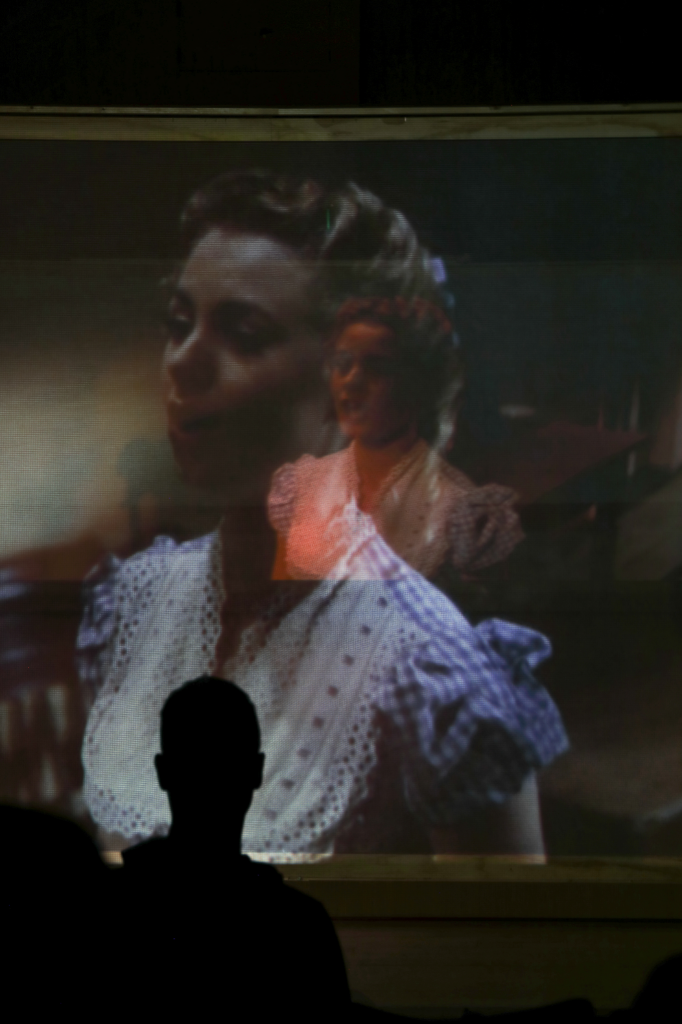When RKO Pictures put Rodgers & Hammerstein’s Oklahoma! on the screen in 1955, it wasn’t because the show was otherwise hard to see. It lasted over five years on Broadway, was quickly put on a national tour, and its cast recording LP (the trend-setting first) was in over a million American homes. What RKO was counting on was the desire to see Curly and Laurey in the sun, blue skies overhead and real grass underneath. Fight with a Stick’s Oh What a Beautiful Morning!, now in an expanded remount playing as part of the Magnetic North Festival, puts the experience back in a room. We start in front of a bargain flat screen television, speakers hoarsely whispering the proud declarations of the film’s trailer to a couch of five. Their reactions are inscrutable.
Perhaps the strangest thing about Beautiful Morning is that, instead of the tradition of community performances referenced in its program notes, the legacy taken head-on is the film adaptations. And, not really the film, but the trailer and its discrete moments—where the film can be approached as if caught unaware of its own implications. Outside of its expanded bookend scenes, Beautiful Morning doesn’t call for performances per se; this is more of a screen installation, an Oklahoma! as post-film debris, the flotsam of Jud Fry and Ado Annie decontextualized and deconstructed. (Extended portions of the screen-based sections are nothing but signs and signifiers.)
There isn’t any recap, in case it’s been awhile since your last encounter with Oklahoma! Nothing about the dramatic love triangle of tall-in-the-saddle Curly, loner farm hand Jud, and their separate pursuits of Laurey, seemingly predestined to fall for the man with the rhyming name. Nothing about the parallel comedic relationship between well-travelled Will and Ado Annie. The community, in essence, isn’t there. Instead we’re confronted with multiple screen panels, our memories, and a resistance to the play’s showstoppers, particularly Ado Annie’s “I Cain’t Say No,” Laurey’s fantasy of mediating between her conflicting desires, and the glossed-over murder that ends the play.
It’s an odd experience to see Beautiful Morning in this particular year, because Oklahoma!, elsewhere on the continent, is having a bit of a moment. Rather than pull the play apart, productions at the Oregon Shakespeare Festival in Ashland and on Broadway have put more life into the show, casting to reflect the diversity of 1906 Oklahoma territory, rather than a 1955 Hollywood backlot, and emphasizing, instead of ignoring, the tensions and disturbing implications of the play. In doing so, they’ve found success: by the end of Beautiful Morning’s run, the Broadway show will likely have a handful of Tony Awards.
Knowing this doesn’t enhance Beautiful Morning—rather than anticipate those works or feed into the same zeitgeist, it exists apart. You could say those American productions come from a love of the stage show, and a desire to do something new to push it outside of safety, outside of fondness. It turns out this might be a flexible, sturdy play. But Beautiful Morning isn’t quite so enamoured. It’s ambivalent, a little bit turned off by all the echoed belting celebratory renditions through the ages. If this is the foundation of a near-century’s worth of the American musical, then is it really a good thing it’s so resilient? Even if there’s a shared concern between all three productions, where those other works are now part of a seemingly overnight galvanized consensus, Beautiful Morning is intended as an outsider critique.
This approach does have its moments: one segment imagines the landscape without its settlers, then inelegantly reintroduces the roofs and haystacks. And the opening gambit, an 11-minute protracted loop of the film’s opening shot, accumulates all the force of a spine-tingling natural event thanks to James Maxwell’s edit of the Rodgers incidental score. But the rest of Beautiful Morning is so ungenerous, even shy about the pleasurable elements of Oklahoma! that it’s something of an aberration.
In trying to piece together fragments that might tell something about the secret currents running underneath a classic, Beautiful Morning points out the obvious, and gives over most of its power to a film that has never been definitive. The finale pulls from the mostly forgotten play that was R&H’s original inspiration. But in all the time it spends duelling with Hollywood and digging up source material, the on-stage action ducks the big question in the room—it never really grapples with Oklahoma! as it really is experienced, on stage and in the imagination.
Oh What a Beautiful Morning! Until June 9, the Russian Hall, 600 Campbell Avenue, Vancouver.
Read more from the Arts.










